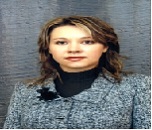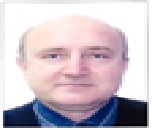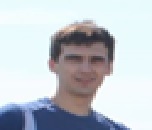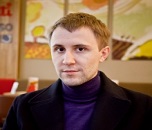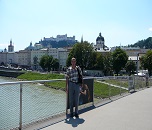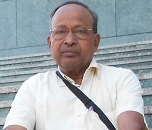Theme: Current Findings and Future Prospects of Particle Physics & Astrophysics
Particle Physics 2017
“Nonlinear wave structures in complex continuous media including atmosphere, hydrosphere and space plasma”
April 14-15, 2017 in Kazan Federal University, Russia
Devoted to the 60th anniversary of start in cosmos of the first artificial satellite of the Earth and 56th anniversary of flight in cosmos of first cosmonaut Jury Gagarin
Chair of Workshop & Program Committee

Prof. Vasily Yu. Belashov
Chief Scientist at the Institute of Physics
Kazan Federal University, Russia
Organizing Committee


Chair: Dr. Oleg Sherstyukov Co-Chair: Dr. Igor Nasyrov
Head of Chair of Radiophysics Associate Professor
Kazan Federal University, Russia Kazan Federal University, Russia
Chief guests & Keynote Speakers

Sergei Popel
Head of Laboratory
Space Research Institute of Russian Academy of Sciences
Russia


Efim Pelinovsky Tatiana Talipova
Chief Scientist Head Scientist
Institute of Applied Physics & Institute of Applied Physics &
State Technical University, Russia State Technical University, Russia


Oleg Kharshiladze Khatuna Chargazia
Associated Professor Researcher
Iv. Javakhishvili Iv. Javakhishvili
Tbilisi State University,Georgia Tbilisi State University, Georgia
Post the Grand Finale of Particle Physics 2016, ConferenceSeries LLC Ltd awesomely elated to announce the inception of the “2nd International Conference on Astrophysics and Particle Physics” proceedings. After Dallas, it’s the turn of the San Antonio, USA to witness the Particle Physics 2017 which is going to be held during November 13-15, 2017.
We invite participants and attendees from all across the map to join us for the 2nd Version the Particle Physics Conference. The conference plans to include significant Keynote demonstrations, Workshops, Symposium, Oral and Poster presentations and Exhibitions.
The conference will bring together scientists, researchers and all related personalities to validate and exchange their innovations and ideas to justify the theme “Current Findings and Future Prospects of Particle Physics & Astrophysics”.
The scientific colloquium will have Astrophysics, Gravitational Physics, Astronomy, Cosmology, Nuclear Physics for Astrophysics and Chemistry Involved in Astronomy as some of the many important sessions.
Track 1: Particle Physics
Particle Physics is the study of nature of the particles that associated with the matter and radiation. It is a study of very small objects. It deals with the sub-atoms which is relate to universe. In the past several decades a huge amount of experimental information has been gathered, and many patterns and methodical features have been observed.
Particle Physics Conference | Physics Conference | Atomic Physics Conference
2nd International Conference on Physics; Aug 28-30, 2017; Brussels, Belgium; 2nd International Conference on Quantum Physics and Quantum Technology; September 25-26, 2017 Berlin, Germany; 2nd International Conference on Astrophysics and Particle Physics; November 13-15, 2017 San Antonio, USA; 2nd International Conference on Atomic and Nuclear Physics; Nov 08-09, 2017 Las Vegas, Nevada, USA; International Conference on High Energy Physics; Dec 11-12, 2017; Rome, Italy; 3rd International Conference on Theoretical Physics and Condensed Matter Physics, October 19-21, 2017 New York, USA; 6th International Conference on Photonics; July 31- August 01, 2017; Milan, Italy; 7th International Conference on Laser Optics; July 31- August 02, 2017; Milan, Italy; Neutron Star Mergers: From Gravitational Waves to Nucleosynthesis January 15 - 21, 2017, Austria; 14th Russbach School Conference on Nuclear Astrophysics, March 12 - 18, 2017, Austria; The AGB-Supernovae Mass Transition, March 27 – 31,2017, Rome, Italy; The Royal Astronomical Society; Astronomical Association; Society for Astronomical Sciences; American association of variable star observer
Track 2: Astrophysics and Space Science
Astrophysics is the subdivision of astronomy. Theoretical astronomy is the study of the investigative models of physics, universe and chemistry to observe and analyse astronomical objects and astronomical phenomena which deals with the space science. It uses a wide range of tools which consists of Analytical models and Computational numerical simulations.
Astrophysics Conference | Space Science Conference | Astronomy Conference
2nd International Conference on Quantum Physics and Quantum Technology; September 25-26, 2017 Berlin, Germany; 2nd International Conference on Astrophysics and Particle Physics; November 13-15, 2017 San Antonio, USA; 2nd International Conference on Physics; Aug 28-30, 2017; Brussels, Belgium; 2nd International Conference on Atomic Physics and Conference on Nuclear Physics; Nov 08-09, 2017 Las Vegas, Nevada, USA; International Conference on High Energy Physics; Dec 11-12, 2017; Rome, Italy; 3rd International Conference on Theoretical and Conference on Condensed Matter Physics, October 19-21, 2017 New York, USA; 6th International Conference on Photonics; July 31- August 01, 2017; Milan, Italy; 7th International Conference on Laser Optics; July 31- August 02, 2017; Milan, Italy; 14th Russbach School Conference on Nuclear Astrophysics, March 12 - 18, 2017, Austria; Current Challenges in the Physics of White Dwarf Stars, June 11 - 16, 2017, New Mexico, USA; The Workshop on Astrophysical Opacities (WAO), August 1 - 4, 2017, Kalamazoo, MI, USA; Astronomical Association of Queensland; Astronomy Association; Society for Astronomical Sciences; Orange country astronomers
Track 3: Dark Matter and Dark Energy
The universe-including Earth, the sun, other stars, and galaxies-is made of protons, neutrons, and electrons bundled together into atoms. The universe appears to be made of a mysterious, invisible substance called dark and a force that repels gravity known as dark energy. Researchers have a few concepts for what dark matter might be. Dark matter consists of exotic particles which don’t interact with normal matter or light but that still exert a gravitational pull.
Dark Matter Conference | Dark Energy Conference | Astrophysics Conference
2nd International Conference on Physics; Aug 28-30, 2017; Brussels, Belgium; 2nd International Conference on Quantum Physics and Quantum Technology; September 25-26, 2017 Berlin, Germany; 2nd International Conference on Astrophysics and Particle Physics; November 13-15, 2017 San Antonio, USA; 2nd International Conference on Atomic Physics and Conference on Nuclear Physics; Nov 08-09, 2017 Las Vegas, Nevada, USA; International Conference on High Energy Physics; Dec 11-12, 2017; Rome, Italy; 3rd International Conference on Theoretical Physics and Conference on Condensed Matter Physics, October 19-21, 2017 New York, USA; 6th International Conference on Photonics; July 31- August 01, 2017; Milan, Italy; 7th International Conference on Laser Optics; July 31- August 02, 2017; Milan, Italy; Neutron Star Mergers: From Gravitational Waves to Nucleosynthesis, January 15 - 21, 2017, Austria; The International Symposium on Strong Electromagnetic Fields and Neutron Stars, May 10 - May 13, 2017, Cuba; The 3rd International Conference on Advances in Radioactive Isotope Science, ARIS 2017, May 28 - June 2, 2017, Utah, USA; RTMC Astronomy Expo; Astronomical Society Of The Desert; The Royal Astronomical Society; Alachua astronomy club; Society for Astronomical Sciences
Track 4: Atomic and Molecular Astrophysics
Atomic astronomy is the exploration of the atomic responses that fuel the Sun and different stars over the Universe furthermore make the assortment of nuclear cores and Understanding the hidden astrophysical procedures gives us pieces of information about starting point of the Earth and its creation; the development of life; the advancement of stars, worlds and the Universe itself; the cause of the components and their plenitudes; By distinguishing and dissecting emanations from stars, the dusty remainders from detonated stars and from reduced "dead" stars; By doing hypothetical counts on atomic conduct and its transaction with the stellar environment furthermore by planning research center examinations that investigate stellar atomic responses in the Big Bang, in stars and in supernova blasts.
Astrophysics Conference | Molecular Astrophysics Conference | Physics Conference
2nd International Conference on Physics; Aug 28-30, 2017; Brussels, Belgium; 2nd International Conference on Quantum Physics and Quantum Technology; September 25-26, 2017 Berlin, Germany; 2nd International Conference on Astrophysics and Particle Physics; November 13-15, 2017 San Antonio, USA; 2nd International Conference on Atomic and Nuclear Physics; Nov 08-09, 2017 Las Vegas, Nevada, USA; International Conference on High Energy Physics; Dec 11-12, 2017; Rome, Italy; 3rd International Conference on Theoretical Physics and Condensed Matter Physics, October 19-21, 2017 New York, USA; 6th International Conference on Photonics; July 31- August 01, 2017; Milan, Italy; 7th International Conference on Laser Optics; July 31- August 02, 2017; Milan, Italy; Neutron Star Mergers: From Gravitational Waves to Nucleosynthesis January 15 - 21, 2017, Austria; 14th Russbach School Conference on Nuclear Astrophysics, March 12 - 18, 2017, Austria; The AGB-Supernovae Mass Transition, March 27 – 31,2017, Rome, Italy; The Royal Astronomical Society; Astronomical Association; Society for Astronomical Sciences; American association of variable star observer
Track 5: Gravitational Physics
Gravitational physicists investigate the ramifications of the general hypothesis of relativity, in which attraction is an outcome of the ebb and flow of space and time. This arch in this manner controls the movement of inertial articles. Present day examine in gravitational material science incorporates contemplating uses of numerical relativity, dark opening elements, wellsprings of gravitational radiation, basic marvels in gravitational fall, the underlying worth issue of general relativity, and relativistic astronomy. The works of Isaac Newton and Albert Einstein rule the advancement of gravitational hypothesis. Newton's established hypotheses of gravitational compel held influence from his Principia, distributed in 1687, until Einstein's work in the mid twentieth century. Newton's hypothesis is adequate even today for everything except the most exact applications. Einstein's hypothesis of general relativity predicts just moment quantitative contrasts from the Newtonian hypothesis aside from in a couple of unique cases. The real centrality of Einstein's hypothesis is its radical applied takeoff from traditional hypothesis and its suggestions for further development in physical thought.
Gravitational Physics Conference | Physics Conference | Astrophysics Conference
2nd International Conference on Quantum Physics and Quantum Technology; September 25-26, 2017 Berlin, Germany; 2nd International Conference on Astrophysics and Particle Physics; November 13-15, 2017 San Antonio, USA; 2nd International Conference on Physics; Aug 28-30, 2017; Brussels, Belgium; 2nd International Conference on Atomic and Nuclear Physics; Nov 08-09, 2017 Las Vegas, Nevada, USA; International Conference on High Energy Physics; Dec 11-12, 2017; Rome, Italy; 3rd International Conference on Theoretical Physics, October 19-21, 2017 New York, USA; 6th International Conference on Photonics; July 31- August 01, 2017; Milan, Italy; 7th International Conference on Laser Optics; July 31- August 02, 2017; Milan, Italy; 14th Russbach School Conference on Nuclear Astrophysics, March 12 - 18, 2017, Austria; Current Challenges in the Physics of White Dwarf Stars, June 11 - 16, 2017, New Mexico, USA; The Workshop on Astrophysical Opacities (WAO), August 1 - 4, 2017, Kalamazoo, MI, USA; Astronomical Association of Queensland; Astronomy Association; Society for Astronomical Sciences; Orange country astronomers
Track 6: Astronomy
The universe-including Earth, the sun, different stars, and cosmic systems is made of protons, neutrons, and electrons packaged together into iotas. Maybe a standout amongst the most shocking disclosures of the twentieth century was that this conventional, or baryonic, matter makes up under 5 percent of the mass of the universe. Whatever is left of the universe has all the earmarks of being made of a puzzling, undetectable substance called dim matter (25 percent) and a constrain that repulses gravity known as dull vitality (70 percent). Researchers have a couple of thoughts for what dim matter may be. One driving speculation is that dark matter comprises of fascinating particles that don't cooperate with ordinary matter or light however that still apply a gravitational draw. Dull vitality is much more baffling, and its revelation in the 1990s was a total stun to researchers. Beforehand, physicists had expected that the appealing power of gravity would back off the extension of the universe after some time. In any case, when two free groups attempted to quantify the rate of deceleration, they found that the development was really accelerating. One researcher compared the finding to tossing an arrangement of keys uncertain anticipating that them should fall down just to see them fly straight up toward the roof.
Astronomy Conference | Astrophysics Conference | Physics Conference
2nd International Conference on Physics; Aug 28-30, 2017; Brussels, Belgium; 2nd International Conference on Quantum Physics and Quantum Technology; September 25-26, 2017 Berlin, Germany; 2nd International Conference on Astrophysics and Particle Physics; November 13-15, 2017 San Antonio, USA; 2nd International Conference on Atomic and Nuclear Physics; Nov 08-09, 2017 Las Vegas, Nevada, USA; International Conference on High Energy Physics; Dec 11-12, 2017; Rome, Italy; Conference on Condensed Matter Physics, October 19-21, 2017 New York, USA; 6th International Conference on Photonics; July 31- August 01, 2017; Milan, Italy; 7th International Conference on Laser Optics; July 31- August 02, 2017; Milan, Italy; Neutron Star Mergers: From Gravitational Waves to Nucleosynthesis, January 15 - 21, 2017, Austria; The International Symposium on Strong Electromagnetic Fields and Neutron Stars, May 10 - May 13, 2017, Cuba; The 3rd International Conference on Advances in Radioactive Isotope Science, ARIS 2017, May 28 - June 2, 2017, Utah, USA; RTMC Astronomy Expo; Astronomical Society Of The Desert; The Royal Astronomical Society; Alachua astronomy club; Society for Astronomical Sciences
Track 7: Cosmology
Our universe is both old and unfathomable, and growing out more distant and quicker consistently. This quickening universe, the dim vitality that is by all accounts behind it and different riddles like the correct way of the Big Bang and the early development of the universe are among the considerable riddles of cosmology. Sensational advances in observational cosmology since the 1990s, including the grandiose microwave foundation, removed supernovae and system redshift studies, have prompted to the improvement of a standard model of cosmology. This model requires the universe to contain a lot of dim matter and dull vitality whose nature is at present not surely knew, but rather the model gives point by point expectations that are in astounding concurrence with numerous assorted perceptions.
Cosmology Conference | Astrophysics Conference | Physics Conference
2nd International Conference on Physics; Aug 28-30, 2017; Brussels, Belgium; 2nd International Conference on Quantum Physics and Quantum Technology; September 25-26, 2017 Berlin, Germany; 2nd International Conference on Astrophysics and Particle Physics; November 13-15, 2017 San Antonio, USA; 2nd International Conference on Atomic Physics ; Nov 08-09, 2017 Las Vegas, Nevada, USA; International Conference on High Energy Physics; Dec 11-12, 2017; Rome, Italy; 3rd International Conference on Theoretical and, October 19-21, 2017 New York, USA; 6th International Conference on Photonics; July 31- August 01, 2017; Milan, Italy; 7th International Conference on Laser Optics; July 31- August 02, 2017; Milan, Italy; Neutron Star Mergers: From Gravitational Waves to Nucleosynthesis January 15 - 21, 2017, Austria; 14th Russbach School Conference on Nuclear Astrophysics, March 12 - 18, 2017, Austria; The AGB-Supernovae Mass Transition, March 27 – 31,2017, Rome, Italy; The Royal Astronomical Society; Astronomical Association; Society for Astronomical Sciences; American association of variable star observer
Track 8: Neutrino Astronomy
We are instructed some further things about the universe past the close planetary system by locating vast beams, which are for the most part arranged of either nuclear cores less their circling electrons, or one of their fundamental segments, protons. However, these decidedly charged particles don't indicate their place of root because of the attractive fields of our cosmic system which influence their flight ways like a magnet influences press filings. The aggregate number of basic particles in the universe, and these impartial feebly cooperating particles emerged to us practically with no inconvenience straight from their sources, making a trip at near the speed of light. A with low vitality of neutrino in flight would not see a hindrance of lead 50 light years thick. When we can see out in neutrino light we will without a doubt get a stunning new perspective of the universe.
Neutrino Astronomy Conference | Astronomy Conference | Astrophysics Conference
2nd International Conference on Quantum Physics and Quantum Technology; September 25-26, 2017 Berlin, Germany; 2nd International Conference on Astrophysics and Particle Physics; November 13-15, 2017 San Antonio, USA; 2nd International Conference on Physics; Aug 28-30, 2017; Brussels, Belgium; 2nd International Conference on Atomic and Nuclear Physics; Nov 08-09, 2017 Las Vegas, Nevada, USA; International Conference on High Energy Physics; Dec 11-12, 2017; Rome, Italy; 6th International Conference on Photonics; July 31- August 01, 2017; Milan, Italy; 7th International Conference on Laser Optics; July 31- August 02, 2017; Milan, Italy; 14th Russbach School Conference on Nuclear Astrophysics, March 12 - 18, 2017, Austria; Current Challenges in the Physics of White Dwarf Stars, June 11 - 16, 2017, New Mexico, USA; The Workshop on Astrophysical Opacities (WAO), August 1 - 4, 2017, Kalamazoo, MI, USA; Astronomical Association of Queensland; Astronomy Association; Society for Astronomical Sciences; Orange country astronomers
Track 9: Nuclear Physics for Astrophysics
Nuclear astronomy is identified with execution nuclear material science estimations which will be utilized by space experts furthermore utilizes nuclear information to decipher cosmic perceptions. Nuclear material science assumes a pivotal part in astronomy and atomic astronomy is the exploration of the atomic responses that fuel the Sun and different stars over the Universe furthermore make the assortment of nuclear cores and Understanding the fundamental astrophysical procedures gives us signs about starting point of the Earth and its organization; the development of life; the advancement of stars, worlds and the Universe itself; the birthplace of the components and their plenitudes; By identifying and breaking down emanations from stars, the dusty leftovers from detonated stars and from smaller "dead" stars; By completing hypothetical estimations on atomic conduct and its interchange with the stellar environment furthermore by planning research center trials that investigate stellar atomic responses in the Big Bang, in stars and in supernova blasts.
Nuclear Physics Conference | Astrophysics Conference | Physics Conference
2nd International Conference on Physics; Aug 28-30, 2017; Brussels, Belgium; 2nd International Conference on Quantum Physics and Quantum Technology; September 25-26, 2017 Berlin, Germany; 2nd International Conference on Astrophysics and Particle Physics; November 13-15, 2017 San Antonio, USA; 2nd International Conference on Atomic; Nov 08-09, 2017 Las Vegas, Nevada, USA; International Conference on High Energy Physics; Dec 11-12, 2017; Rome, Italy; 3rd International Conference on Theoretical Physics, October 19-21, 2017 New York, USA; 6th International Conference on Photonics; July 31- August 01, 2017; Milan, Italy; 7th International Conference on Laser Optics; July 31- August 02, 2017; Milan, Italy; Neutron Star Mergers: From Gravitational Waves to Nucleosynthesis, January 15 - 21, 2017, Austria; The International Symposium on Strong Electromagnetic Fields and Neutron Stars, May 10 - May 13, 2017, Cuba; The 3rd International Conference on Advances in Radioactive Isotope Science, ARIS 2017, May 28 - June 2, 2017, Utah, USA; RTMC Astronomy Expo; Astronomical Society Of The Desert; The Royal Astronomical Society; Alachua astronomy club; Society for Astronomical Sciences
Track 10: Chemistry Involved in Astronomy
Researchers are anticipating another period of cosmology with the disclosure of the main sub-nuclear neutrino particles from profound space, which could give new bits of knowledge into enormous occasions in removed areas of the Universe, for example, detonating stars and dark gaps.
Astronomy Conference | Astrophysics Conference | Physics Conference
2nd International Conference on Physics; Aug 28-30, 2017; Brussels, Belgium; 2nd International Conference on Quantum Physics and Quantum Technology; September 25-26, 2017 Berlin, Germany; 2nd International Conference on Astrophysics and Particle Physics; November 13-15, 2017 San Antonio, USA; International Conference on High Energy Physics; Dec 11-12, 2017; Rome, Italy; 3rd International Conference on Theoretical Physics, October 19-21, 2017 New York, USA; 6th International Conference on Photonics; July 31- August 01, 2017; Milan, Italy; 7th International Conference on Laser Optics; July 31- August 02, 2017; Milan, Italy; Neutron Star Mergers: From Gravitational Waves to Nucleosynthesis January 15 - 21, 2017, Austria; 14th Russbach School Conference on Nuclear Astrophysics, March 12 - 18, 2017, Austria; The AGB-Supernovae Mass Transition, March 27 – 31,2017, Rome, Italy; The Royal Astronomical Society; Astronomical Association; Society for Astronomical Sciences; American association of variable star observer
Track 11: Instrumentation
Material science of the early Universe is at the limit of stargazing and reasoning since we don't as of now has an entire hypothesis that binds together all the basic strengths of Nature right now of Creation. Furthermore, there is no probability of connecting perception or experimentation of early Universe material science to our hypotheses (i.e. it's impractical to `build' another Universe). Our speculations are dismisses or acknowledged in view of straightforwardness and stylish grounds, in addition to their force of expectation to later circumstances, instead of an interest to observational outcomes. This is an extremely contrast method for doing science from earlier hundreds of years of research.
Astrophysics Conference | Astronomy Conference | Physics Conference
2nd International Conference on Quantum Physics and Quantum Technology; September 25-26, 2017 Berlin, Germany; 2nd International Conference on Astrophysics and Particle Physics; November 13-15, 2017 San Antonio, USA; 2nd International Conference on Physics; Aug 28-30, 2017; Brussels, Belgium; 2nd International Conference on Atomic Physics ; Nov 08-09, 2017 Las Vegas, Nevada, USA; International Conference on High Energy Physics; Dec 11-12, 2017; Rome, Italy; 3rd International Conference on Theoretical Physics, October 19-21, 2017 New York, USA; 6th International Conference on Photonics; July 31- August 01, 2017; Milan, Italy; 7th International Conference on Laser Optics; July 31- August 02, 2017; Milan, Italy; 14th Russbach School Conference on Nuclear Astrophysics, March 12 - 18, 2017, Austria; Current Challenges in the Physics of White Dwarf Stars, June 11 - 16, 2017, New Mexico, USA; The Workshop on Astrophysical Opacities (WAO), August 1 - 4, 2017, Kalamazoo, MI, USA; Astronomical Association of Queensland; Astronomy Association; Society for Astronomical Sciences; Orange country astronomers
Track 12: Particle Accelerators
Observational stargazing is one of the arrangements of the galactic science that is connected with recording information, conversely with Theoretical astronomy, which is for the most part worried with discovering the quantifiable ramifications of physical models. It is the act of watching divine protests by utilizing telescopes and other galactic contraption. Radio cosmology is the branch of Astronomy which concentrates heavenly bodies at Radio Frequencies. Infrared cosmology is the division of space science and astronomy that reviews galactic articles obvious in infrared (IR) radiation as it were. Optical Astronomy is additionally called as Visible Light Astronomy. Bright space science is the perception of electromagnetic radiation at bright wavelengths comparably X-beam Astronomy utilizes X-beams and Gamma beam Astronomy utilizes Gamma beams
Sky overviews and mappings of the different wavelength groups of electromagnetic radiation have yielded much data on the substance and character of the universe's structure. The association of structure seems to take after as a progressive model with association up to the size of super groups and fibers.
Particle Physics Conference | Astrophysics Conference | Physics Conference
2nd International Conference on Physics; Aug 28-30, 2017; Brussels, Belgium; 2nd International Conference on Quantum Physics and Quantum Technology; September 25-26, 2017 Berlin, Germany; 2nd International Conference on Astrophysics and Particle Physics; November 13-15, 2017 San Antonio, USA; 2nd International Conference on Atomic Physics; Nov 08-09, 2017 Las Vegas, Nevada, USA; International Conference on High Energy Physics; Dec 11-12, 2017; Rome, Italy; 6th International Conference on Photonics; July 31- August 01, 2017; Milan, Italy; 7th International Conference on Laser Optics; July 31- August 02, 2017; Milan, Italy; Neutron Star Mergers: From Gravitational Waves to Nucleosynthesis, January 15 - 21, 2017, Austria; The International Symposium on Strong Electromagnetic Fields and Neutron Stars, May 10 - May 13, 2017, Cuba; The 3rd International Conference on Advances in Radioactive Isotope Science, ARIS 2017, May 28 - June 2, 2017, Utah, USA; RTMC Astronomy Expo; Astronomical Society Of The Desert; The Royal Astronomical Society; Alachua astronomy club; Society for Astronomical Sciences
Track 13: Higgs Physics
The Higgs boson is an elementary particle in the Standard Model of particle physics. It is the quantum excitation of the Higgs field
Higgs Physics Conference | Physics Conference | Astrophysics Conference
2nd International Conference on Physics; Aug 28-30, 2017; Brussels, Belgium; 2nd International Conference on Quantum Physics and Quantum Technology; September 25-26, 2017 Berlin, Germany; 2nd International Conference on Astrophysics and Particle Physics; November 13-15, 2017 San Antonio, USA; 2nd International Conference on Atomic and Nuclear Physics; Nov 08-09, 2017 Las Vegas, Nevada, USA; International Conference on High Energy Physics; Dec 11-12, 2017; Rome, Italy; 3rd International Conference on Theoretical and Condensed Matter Physics, October 19-21, 2017 New York, USA; 6th International Conference on Photonics; July 31- August 01, 2017; Milan, Italy; 7th International Conference on Laser Optics; July 31- August 02, 2017; Milan, Italy; Neutron Star Mergers: From Gravitational Waves to Nucleosynthesis, January 15 - 21, 2017, Austria; The International Symposium on Strong Electromagnetic Fields and Neutron Stars, May 10 - May 13, 2017, Cuba; The 3rd International Conference on Advances in Radioactive Isotope Science, ARIS 2017, May 28 - June 2, 2017, Utah, USA; RTMC Astronomy Expo; Astronomical Society Of The Desert; The Royal Astronomical Society; Alachua astronomy club; Society for Astronomical Sciences
Track 14: Heavy-ion physics
Atomic material science and Particle Physics is the zone of material science that reviews nuclear cores and their components and cooperations. The most usually known sort of atomic material science is atomic power era, the examination has hurry to tenders in many fields, including atomic medicine and attractive resonation imaging, atomic weapons, particle implantation in materials building, and radiocarbon dating in geography and archaic exploration.
Heavy-ion Physics Conference | Physics Conference | Astrophysics Conference
2nd International Conference on Quantum Physics and Quantum Technology; September 25-26, 2017 Berlin, Germany; 2nd International Conference on Astrophysics and Particle Physics; November 13-15, 2017 San Antonio, USA; 2nd International Conference on Physics; Aug 28-30, 2017; Brussels, Belgium; International Conference on High Energy Physics; Dec 11-12, 2017; Rome, Italy; 6th International Conference on Photonics; July 31- August 01, 2017; Milan, Italy; 7th International Conference on Laser Optics; July 31- August 02, 2017; Milan, Italy; 14th Russbach School Conference on Nuclear Astrophysics, March 12 - 18, 2017, Austria; Current Challenges in the Physics of White Dwarf Stars, June 11 - 16, 2017, New Mexico, USA; The Workshop on Astrophysical Opacities (WAO), August 1 - 4, 2017, Kalamazoo, MI, USA; Astronomical Association of Queensland; Astronomy Association; Society for Astronomical Sciences; Orange country astronomers
Track 15: High Energy Physics
In the high-vitality atomic material science we test that atomic matter is on the level of its crucial constituents, for example, quarks and gluons. The stage move between de limited quark-gluon matter, typical quark-gluon matter and ordinary atomic matter is called as Quark Gluon Plasma. In the high vitality impacts of overwhelming cores quarks and gluons are discharged from the hadronic limits of matter and along these lines the new condition of matter is framed which is likewise called as Quark-gluon plasma. The move from the hadronic matter where neutrons, protons and different hadrons are singular particles to the quark-gluon plasma stage which is a clear expectation to the hypothesis of solid associations. For the most part the high vitality impacts of overwhelming cores that is plasma which lives just for 10-22 sec since it returns to the hadronic stage when its quick development is chilled off.
High Energy Physics Conference | Physics Conference | Astrophysics Conference
2nd International Conference on Physics; Aug 28-30, 2017; Brussels, Belgium; 2nd International Conference on Quantum Physics and Quantum Technology; September 25-26, 2017 Berlin, Germany; 2nd International Conference on Astrophysics and Particle Physics; November 13-15, 2017 San Antonio, USA; International Conference on High Energy Physics; Dec 11-12, 2017; Rome, Italy; 6th International Conference on Photonics; July 31- August 01, 2017; Milan, Italy; 7th International Conference on Laser Optics; July 31- August 02, 2017; Milan, Italy; Neutron Star Mergers: From Gravitational Waves to Nucleosynthesis, January 15 - 21, 2017, Austria; The International Symposium on Strong Electromagnetic Fields and Neutron Stars, May 10 - May 13, 2017, Cuba; The 3rd International Conference on Advances in Radioactive Isotope Science, ARIS 2017, May 28 - June 2, 2017, Utah, USA; RTMC Astronomy Expo; Astronomical Society Of The Desert; The Royal Astronomical Society; Alachua astronomy club; Society for Astronomical Sciences
ConferenceSeries LLC Ltd Conferences invites all the participants from all over the world to attend “2nd International conference on Astrophysics and Particle Physics” during November 13-15, 2017, San Antonio, USA which includes prompt keynote presentations, Oral talks, Poster presentations and Exhibitions.
Particle Physics 2017 aims to bring together a multi-disciplinary group of scientists and engineers to present and exchange breakthrough ideas relating to Early Universe, Dark Matter and Dark Energy, Gravitational Physics, Particle and Nuclear Astrophysics, Large-Scale Structures, Stellar Formation and Evolution, Observational Astronomy and Astrophysics, Celestial Mechanics, Theoretical Astronomy and Astrophysics, Astronomy Subfields, Interdisciplinary Studies, Space Observation and Exploration, Structure and Evolution of the Cosmos, Unsolved Problems in Astronomy. It promotes top-level research and to globalize the quality research in general, thus making discussions, presentations and contributions more internationally competitive.
Importance& Scope:
The existence of the Earth's galaxy, the Milky Way, as a separate group of stars, was only proved in the 20th century, along with the existence of "external" galaxies, and soon after, the expansion of the Universe, seen in the recession of most galaxies from us. Modern astronomy has also discovered many exotic objects such as quasars, pulsars, blazars, and radio galaxies, and has used these observations to develop physical theories which describe some of these objects in terms of equally exotic objects such as black holes and neutron stars. Physical cosmology made huge advances during the 20th century, with the model of the Big Bang heavily supported by the evidence provided by astronomy and physics, such as the cosmic microwave background radiation, Hubble's law, and cosmological abundances of elements. Space telescopes have enabled measurements in parts of the electromagnetic spectrum normally blocked or blurred by the atmosphere. The core aim of Particle Physics 2017 conference is to provide an opportunity for the delegates to meet, interact and exchange new ideas in the various areas of Astrophysics.
Why to attend?
The aim of Particle Physics 2017 meeting is to bring together a multi-disciplinary group of scientists and engineers to present and exchange breakthrough ideas relating to Early universe, Dark matter and dark energy, Gravitational physics, Particle and nuclear astrophysics, Large-scale structures, Stellar formation and evolution, Solar physics. It promotes top-level research and to globalize the quality research in general, thus making discussions, presentations and contributions more internationally competitive.
Target Audience:
- Aerospace Engineers
- Aeronautical Engineers
- Mechanical Engineers
- Instrumentation Engineers
- Electrical Engineers
- Electronic and Communication Engineers
- Astronomers
- Scientists
- Professors
- Students
Summary:
Astrophysics is the subdivision of astronomy. Theoretical astronomy is the study of the investigative models of physics, universe and chemistry to observe and analyse astronomical objects and astronomical phenomena which deals with the space science. It uses a wide range of tools which consists of Analytical models and Computational numerical simulations. Astronomy is one of the oldest sciences. The early civilizations in recorded history to perform methodical observations of the night sky. However, the invention of the telescope was required before astronomy was able to develop into a modern science. Significant advances in astronomy came about with the introduction of new technology, including the spectroscope and photography.
Conference series LLC Ltd invites you to the 2nd International conference on Astrophysics and Particle Physics with the theme “Current Findings and Future Prospects of Particle Physics & Astrophysics”.The conference will be held on November 13-15, 2017 at San Antonio, Texas, USA. This is an excellent meeting with great scientists from different countries around the world to sharing new and exciting results in Astrophysics and Particle Physics, this exciting and informative conference program including plenary lectures, symposia, workshops, poster presentations and various programs for participants from all over the world.
Importance & Scope:
The existence of the Earth's galaxy, the Milky Way, as a separate group of stars, was only proved in the 20th century, along with the existence of "external" galaxies, and soon after, the expansion of the Universe, seen in the recession of most galaxies from us. Modern astronomy has also discovered many exotic objects such as quasars, pulsars, blazars, and radio galaxies, and has used these observations to develop physical theories which describe some of these objects in terms of equally exotic objects such as black holes and neutron stars. Physical cosmology made huge advances during the 20th century, with the model of the Big Bang heavily supported by the evidence provided by astronomy and physics, such as the cosmic microwave background radiation, Hubble's law, and cosmological abundances of elements. Space telescopes have enabled measurements in parts of the electromagnetic spectrum normally blocked or blurred by the atmosphere. The core aim of Particle Physics 2017 conference is to provide an opportunity for the delegates to meet, interact and exchange new ideas in the various areas of Astrophysics and Particle Physics.
Why San Antonio, USA?
San Antonio is a seventh populated city and and the second most populated city in the state Texas USA. It has the population around 1,402,675. The city straddles South Texas and Central Texas and is on the south-western corner of an urban megaregion known as the Texas Triangle. In 1845, the United States decided to occupy Texas and include it as a state in the Union. This led to the Mexican-American War. Though the US ultimately won, the war was devastating to San Antonio reducing its population to almost two-third. San Antonio’s economy is focused primarily within military, health care, government civil service, financial services, oil and gas and tourism sectors. It has a diversified economy with about a $96.8 billion metropolitan Gross Domestic Product. This ranks the city 4th among Texas metropolitan areas and 38th in the United States.
San Antonio is centrally located between both coasts, so attendees don’t have to make cross-country flights. And with 26 million Texans, most are just a drive away. Great weather and temperate winters make San Antonio a great solution for those with seasonal weather challenges (or for those who enjoy year-round golf). Over 300 days of sunshine each year and an inland location provide worry-free planning options in all seasons. San Antonio’s unique heritage and mix of cultures gave way to a culinary landscape that’s truly one-of-a-kind. While we’re famous for our signature Tex-Mex, you’ll also find traditional Mexican cuisine along with German, French, English and Italian eateries. Quiet wine bars, well-known watering holes, lively dance halls and a duelling piano sing-along are just a few of the many popular stops.
Why to attend?
The aim of Particle Physics 2017 meeting is to bring together scientists to present and exchange breakthrough ideas relating to Astrophysics and Particle Physics. It promotes top-level research and to globalize the quality research in general, thus making discussions, presentations and contributions more internationally competitive.
Major Astronomy and Astrophysics Associations around the Globe:
- The Royal Astronomical Society
- International Astronomical Union
- Amateur Astronomers Association of Pittsburgh
- International Meteor Organization
- The Planetary Society
- Astronomical Association of Queensland
- Astronomical Institute of Amsterdam
- Astronomical League
- Astronomical Society at the University of Illinois
- Astronomical Society of Palm Beaches
Major Astrophysics Associations in USA:
- American Astronomical Society
- American Association of Variable Star Observers
- American Meteor Society
- Southern Cross Astronomical Society
- Northern Virginia Astronomy Club
- Astronomical Society of Nevada
- Las Vegas Astronomical Society
- Mohawk Valley Astronomical Society
- Federation of Astronomical Societies
- British Astronomical Association
Target Audience:
Eminent Scientists/Research Professors, Junior/Senior research fellows, Students, Directors of companies, Members of different physics associations.

Top Universities in USA:
Harvard University
Stanford University
University of California, Berkeley
Massachusetts Institute of Technology (MIT)
Princeton University
Columbia University
University of Chicago
Yale University
Global University
University of California, Los Angeles
University of Pennsylvania
Cornell University
University of California, San Diego
University of Michigan
Johns Hopkins University
University of Washington
University of Texas at Austin
Duke University
Northwestern University
Jesuit School of Theology of Santa Clara University

Glance at Market of Astrophysics:
Institutional budgets are critical in starting-up and developing capital-intensive and high technology sectors such as space. Government Budget Appropriations or Outlays for R&D (GBAORD) data are assembled by national authorities analysing their budget for R&D content and classifying them by “socio-economic objective”. These diverse objec- tives represent the intention of the government at the time of funding commitment, and a special category “explora- tion and exploitation of space” exists. Although the data provide only a partial picture of space investments (see note below), the long-term time-series provide useful trends on policy orientations.
In 2013, total civil GBAORD for space programmes for all OECD countries amounted to USD 19.2 billion PPP. The United States had the highest GBAORD for space programmes at USD 10.6 billion PPP, followed by the Russian Federation (USD 3.3 billion PPP), Japan (USD 2.2 billion PPP) and France (USD 1.7 billion PPP). The United States was also the country in which space programmes took the highest percentage of total civil GBAORD, at 16.9%, followed by France (10.4%) and Belgium (8.7%). The OECD-wide mean average represented 7.7% in 2013.
Compared to trends seen in previous editions of The Space Economy at a Glance, there is a global 2% decrease in GBAORD for space programmes for the OECD area in 2013. The share of space programmes in total civil GBAORD also decreased from 9.1% to 7.5%, mostly due to a decrease in the United States. However, there are no strong negative trends for a majority of countries, with a number of economies (France, Germany, Japan) having actually increased their outlays for space R&D in the last couple of years.
The global space sector is a high-technology niche with a complex ecosystem, which employed at least 900 000 persons around the world in 2013, including public
Administrations (space agencies, space departments in civil and defence-related organisations), the space manufacturing industry (building rockets, satellites, ground systems); direct suppliers to this industry (components), and the wider space services sector (mainly commercial satellite telecommunications). But these estimates do not take into account universities and research institutions, which also play a key role in R&D, as receivers of public contracts and initiators of much of the space sector’s innovation.
The acquisition and development of space capabilities remains a highly attractive strategic goal, and the number of countries and companies investing in space systems and their downstream applications continues to grow. Despite the economic crisis, institutional funding remained stable in 2013 on a global scale, with increased budgets in several OECD countries and emerging economies. Space often has a reputation for being expensive, but national investments represent only a very small percentage relative to GDP in all G20 countries. In the United States, the largest programme in the world, space represents only 0.3% of GDP and in France, less than 0.1% of GDP.
Although OECD countries accounted for the largest space budgets globally in 2013 (USD 52 billion, using purchasing power parities or PPPs), an increasing part of global space activities takes place outside of the OECD, particularly in Brazil, the Russian Federation, India and China (around USD 23.9 billion PPPs).
The space economy represented some USD 256.2 billion in revenues in 2013, divided between the space manufacturing supply chain (33%), satellite operators (8.4%) and consumer services (58%), including actors who rely on some satellite capacity for part of their revenues, such as direct-to-home satellite television services providers.
Conference Highlights
- Particle Physics
- Astrophysics and Space Science
- Dark Matter and Dark Energy
- Atomic and Molecular Astrophysics
- Gravitational Physics
- Astronomy
- Cosmology
- Neutrino Astronomy
- Nuclear Astrophysics
- Astrochemistry and Astrobiology
- Instrumentation
- Plasma Physics
- Higgs Particle Physics
- Heavy-ion physics
- High Energy Physics
- Optical Astronomy
- Space Missions & Satellite
To share your views and research, please click here to register for the Conference.
To Collaborate Scientific Professionals around the World
| Conference Date | November 13-15, 2017 | ||
| Sponsors & Exhibitors |
|
||
| Speaker Opportunity Closed | Day 1 | Day 2 | Day 3 |
| Poster Opportunity Closed | Click Here to View | ||
Useful Links
Special Issues
All accepted abstracts will be published in respective Our International Journals.
- Journal of Astrophysics & Aerospace Technology
- Journal of Pure and Applied Physics
- Journal of Lasers, Optics & Photonics
Abstracts will be provided with Digital Object Identifier by




















